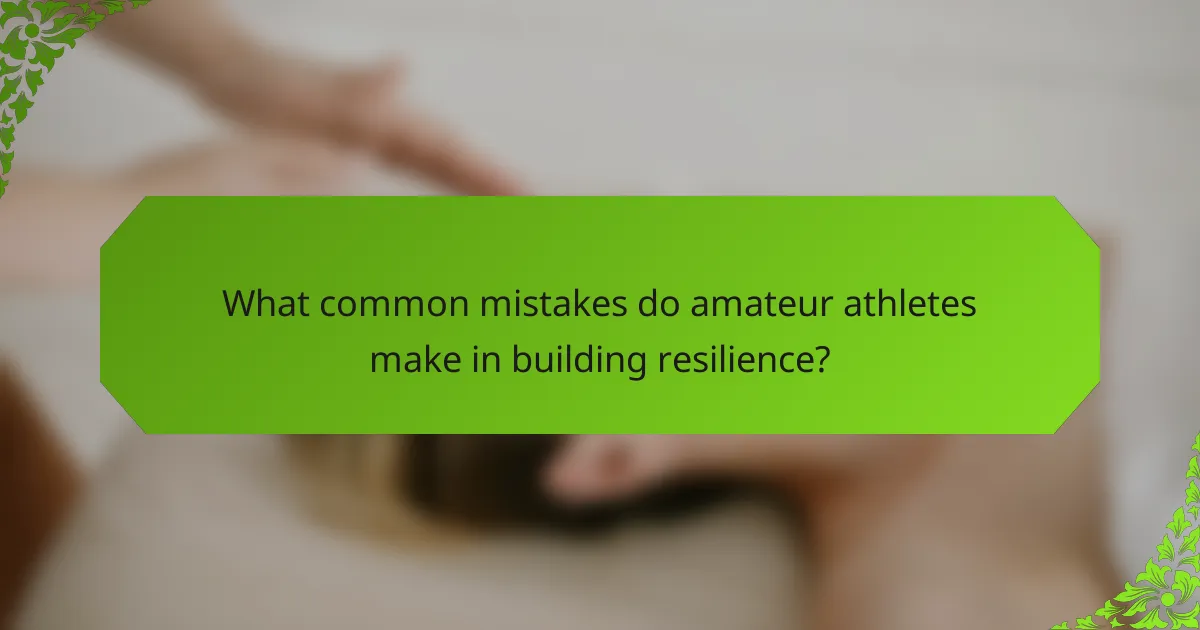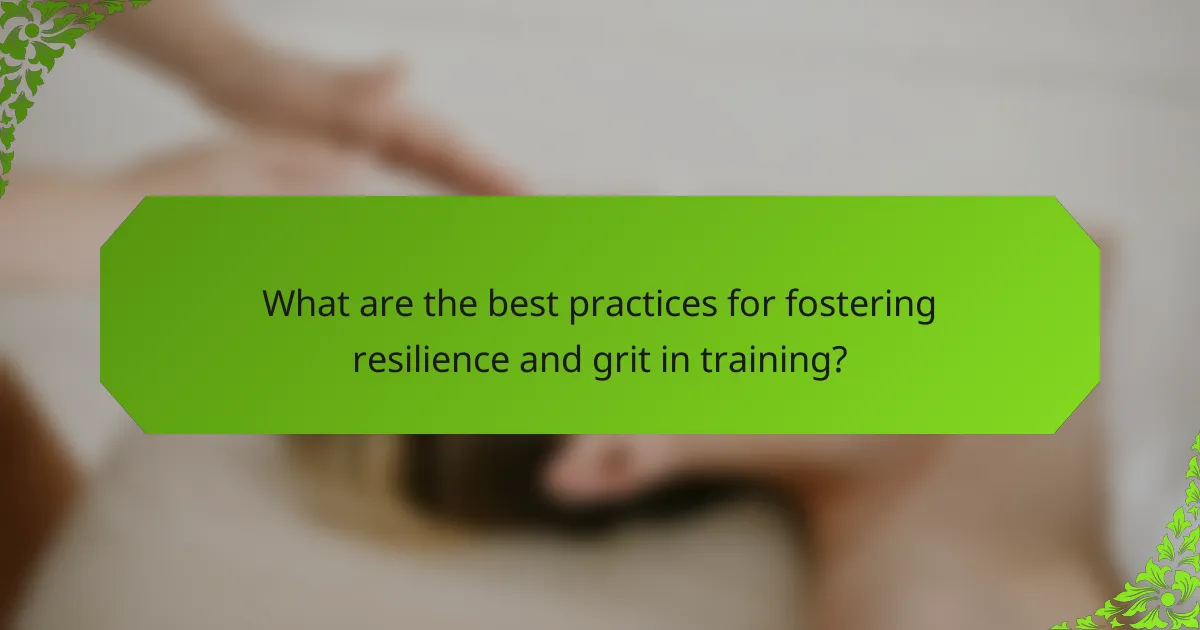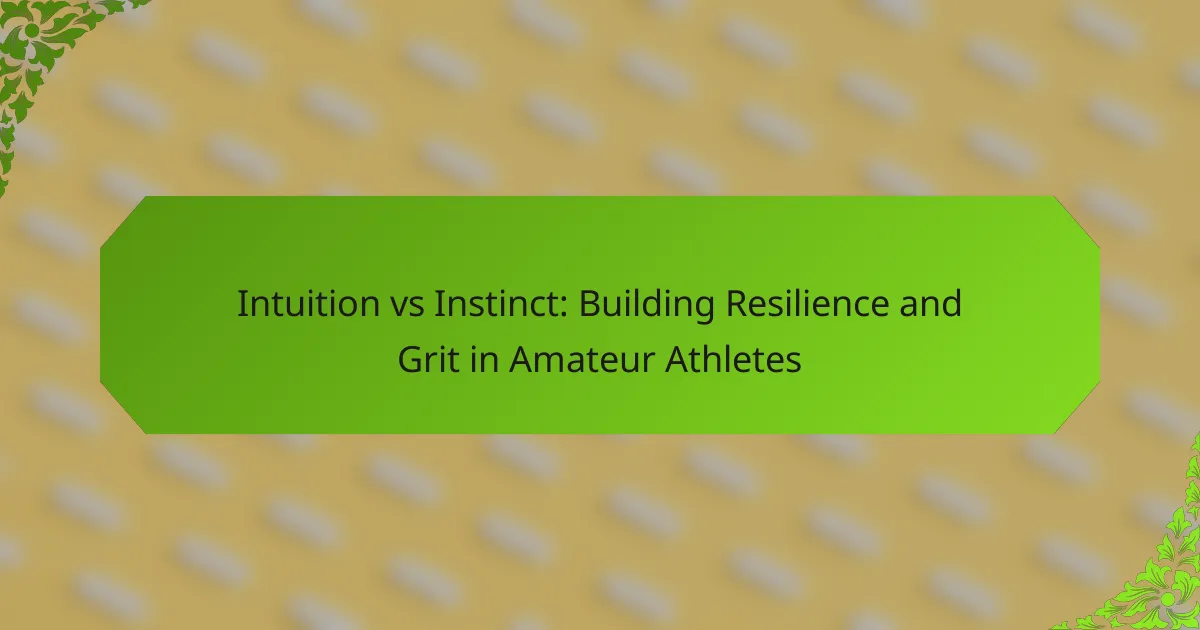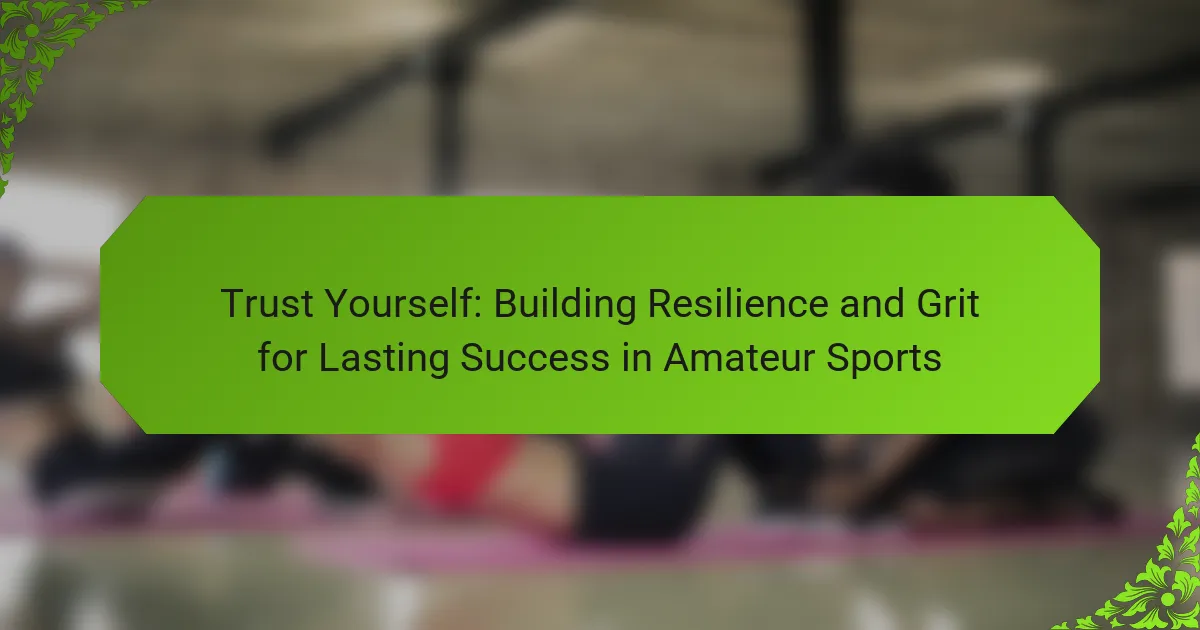Amateur athletes often grapple with the fear of being forgotten, which can hinder their motivation and mental resilience. This article explores how this fear fosters grit and determination while providing strategies to build resilience. Key practices include developing a growth mindset, setting realistic goals, and engaging with a supportive community. Additionally, unique methods like narrative reframing and mindfulness meditation can enhance emotional regulation and coping mechanisms.

How does the fear of being forgotten impact amateur athletes?
The fear of being forgotten can significantly impact amateur athletes by influencing their motivation and mental resilience. This fear often drives athletes to push themselves harder, fostering grit and determination. As a result, they may develop stronger coping mechanisms to handle setbacks and maintain focus on their goals. Additionally, the desire for recognition can lead to enhanced performance, as athletes strive to leave a lasting impression. Ultimately, this fear can serve as a double-edged sword, motivating athletes while also risking burnout if not managed effectively.
What psychological effects does this fear create?
The fear of being forgotten can lead to feelings of anxiety, low self-worth, and isolation in amateur athletes. This fear often manifests as a constant pressure to perform, which can hinder their enjoyment of the sport. As a result, athletes may experience burnout or withdrawal from competition. Developing resilience and grit can counteract these psychological effects, fostering a healthier mindset and enhancing overall performance.
How does this fear influence performance and motivation?
Fear of being forgotten can significantly hinder performance and motivation in amateur athletes. This fear often leads to anxiety, which can impair focus and decision-making during competitions. As a result, athletes may struggle to perform at their best, diminishing their overall success and satisfaction in their sport. Building resilience and grit can counteract these effects, fostering a more positive mindset and enhancing motivation. Athletes who cultivate these traits are more likely to embrace challenges and persist despite setbacks, ultimately improving their performance.

What are the universal resilience practices for amateur athletes?
Universal resilience practices for amateur athletes include fostering a growth mindset, setting realistic goals, and maintaining a strong support network. These practices enhance perseverance and adaptability during challenges.
1. **Growth Mindset**: Emphasizing learning from failures fosters resilience.
2. **Goal Setting**: Establishing achievable short-term and long-term objectives builds motivation.
3. **Support Network**: Engaging with coaches, peers, and family provides emotional and practical support.
4. **Mindfulness Techniques**: Practicing mindfulness reduces anxiety and improves focus.
5. **Physical Recovery**: Prioritizing rest and recovery aids mental resilience.
6. **Consistent Training**: Regular practice builds confidence and grit over time.
How can setting achievable goals enhance resilience?
Setting achievable goals enhances resilience by providing clear direction and measurable progress. This structured approach helps amateur athletes build grit, overcome challenges, and maintain motivation. Research indicates that goal-setting fosters a sense of accomplishment, reinforcing perseverance in the face of setbacks. By focusing on attainable objectives, athletes can navigate their journeys with confidence and adaptability, crucial traits for resilience.
What role does community support play in building grit?
Community support significantly enhances grit by providing emotional encouragement and practical resources. This support fosters resilience in amateur athletes, helping them overcome challenges and setbacks. Engaging with a community creates a sense of belonging, which can motivate individuals to persist in their training and competition. Research shows that athletes with strong community ties report higher levels of determination and mental toughness. This unique attribute of community support plays a crucial role in sustaining motivation and resilience throughout the athletic journey.

What unique strategies can athletes adopt to combat the fear of being forgotten?
Athletes can combat the fear of being forgotten by adopting unique strategies that enhance their mental resilience. Engaging in self-reflection allows athletes to recognize their achievements and growth, reinforcing their sense of purpose. Building a supportive community fosters connections that remind athletes of their impact on others. Setting personal goals shifts focus from external validation to intrinsic motivation, enhancing grit. Utilizing visualization techniques can help athletes envision their legacy, creating a lasting mental image that counters feelings of insignificance. Finally, sharing their journey through storytelling can inspire others, solidifying their presence in the sport.
How can personal storytelling foster connection and resilience?
Personal storytelling cultivates connection and resilience by fostering empathy and shared experiences among amateur athletes. By sharing their journeys, athletes confront the fear of being forgotten, reinforcing their grit. This process builds a supportive community that enhances mental toughness. Engaging narratives allow athletes to reflect on challenges, promoting personal growth and resilience.
What innovative training techniques can reinforce mental toughness?
Innovative training techniques that reinforce mental toughness include visualization, goal setting, and resilience training. These methods enhance focus and determination, crucial for amateur athletes facing challenges in their journeys.
Visualization involves mentally rehearsing successful outcomes, helping athletes build confidence. Goal setting creates clear, achievable targets, fostering a sense of purpose. Resilience training incorporates strategies like mindfulness and stress management, enabling athletes to cope with setbacks effectively.
Collectively, these techniques cultivate grit, allowing amateur athletes to overcome the fear of being forgotten.

What rare but effective resilience practices exist for amateur athletes?
Amateur athletes can adopt rare yet effective resilience practices to combat the fear of being forgotten. One such practice is narrative reframing, which involves athletes telling their stories of struggle and triumph to build grit and foster connection. Another is mindfulness meditation, which enhances focus and emotional regulation, allowing athletes to navigate challenges more effectively. Additionally, embracing failure as a learning opportunity can cultivate resilience, encouraging athletes to view setbacks as integral to their growth. Finally, engaging in community support networks can provide emotional reinforcement, helping athletes feel valued and less isolated in their journeys.
How can visualization techniques aid in overcoming performance anxiety?
Visualization techniques effectively reduce performance anxiety by enhancing focus and confidence. By mentally rehearsing successful outcomes, amateur athletes can create a positive mindset. This practice activates neural pathways associated with performance, making actual execution feel more familiar. Research shows that athletes who visualize their performances experience less anxiety and improved outcomes. Incorporating visualization into training routines fosters resilience and grit, crucial attributes for overcoming challenges in athletic journeys.
What is the role of mentorship in developing grit?
Mentorship plays a crucial role in developing grit by providing guidance, support, and motivation. It helps amateur athletes navigate challenges, fostering resilience through constructive feedback and shared experiences. Mentors instill a growth mindset, encouraging athletes to embrace setbacks as learning opportunities. This relationship enhances commitment and perseverance, essential for achieving long-term goals in sports.
How can athletes find and approach potential mentors?
Athletes can find and approach potential mentors by leveraging networking opportunities and demonstrating genuine interest. Attend sports events, workshops, and seminars to connect with experienced individuals. Utilize social media platforms to reach out, expressing admiration for their work and seeking advice. Personalize your communication to stand out. Establishing a clear goal for mentorship enhances the approach. As a result, this proactive strategy builds resilience and grit, essential for amateur athletes’ journeys.

What common mistakes do amateur athletes make in building resilience?
Amateur athletes often make critical mistakes that hinder their resilience. Common errors include neglecting mental training, underestimating recovery, and focusing solely on physical performance. They may also avoid seeking feedback, which limits growth. Lastly, many fail to set realistic goals, leading to frustration and burnout.
How can athletes avoid burnout while pursuing their goals?
Athletes can avoid burnout by prioritizing mental health, setting realistic goals, and maintaining a balanced training schedule. Incorporating recovery strategies, such as rest days and mindfulness practices, enhances resilience. Building grit involves embracing challenges and learning from setbacks, fostering a growth mindset. Regularly evaluating progress helps athletes stay aligned with their aspirations, reducing feelings of being forgotten.
What should athletes know about balancing competition and personal growth?
Athletes should prioritize personal growth alongside competition to build resilience and grit. Balancing these aspects fosters mental toughness, enhancing performance. Setting personal goals, seeking feedback, and reflecting on experiences contribute to long-term development. Engaging in diverse training methods can also promote adaptability, a unique attribute valuable in competitive environments. Emphasizing growth over solely winning reduces pressure and cultivates a healthier mindset.

What are the best practices for fostering resilience and grit in training?
To foster resilience and grit in training, focus on consistent goal-setting, positive reinforcement, and adaptive challenges. Encourage athletes to embrace failures as learning opportunities, promoting a growth mindset. Incorporate mental conditioning techniques, such as visualization and mindfulness, to enhance emotional regulation. Regularly assess progress and celebrate small achievements to build confidence and motivation.
How can athletes create a consistent routine that supports mental strength?
Athletes can create a consistent routine that supports mental strength by establishing daily habits and setting clear goals. Consistency fosters resilience, allowing athletes to navigate challenges effectively. Incorporating mindfulness practices, such as meditation, enhances focus and emotional regulation. Regular physical training, combined with mental conditioning exercises, builds grit and perseverance. Tracking progress through journaling or apps reinforces commitment and accountability. Engaging with supportive communities further strengthens mental fortitude, providing encouragement and shared experiences.
What techniques can be used to reflect on and learn from failures?
To reflect on and learn from failures, amateur athletes can employ techniques such as journaling, seeking feedback, and practicing mindfulness. Journaling allows athletes to document experiences, analyze emotions, and identify patterns. Seeking feedback from coaches or peers provides external perspectives, fostering growth. Mindfulness practices enhance self-awareness, enabling athletes to process setbacks constructively. By integrating these techniques, athletes can build resilience and grit, transforming failures into valuable learning opportunities.

How can amateur athletes optimize their resilience practices for long-term success?
Amateur athletes can optimize their resilience practices by focusing on consistent training, mental toughness, and support systems. Regularly setting achievable goals builds confidence and grit. Incorporating mindfulness techniques enhances focus and emotional regulation. Engaging with a community fosters accountability and motivation. Tracking progress helps identify strengths and areas for improvement.
What strategies can be implemented for ongoing self-assessment and improvement?
Ongoing self-assessment and improvement can be achieved through regular reflection, goal setting, and feedback mechanisms. Athletes should maintain a journal to track progress and emotions, establishing specific, measurable goals. Engaging with coaches and peers for constructive feedback fosters growth. Incorporating mental resilience training enhances adaptability to challenges, reinforcing grit.
How can athletes build a legacy that transcends their fear of being forgotten?
Athletes can build a lasting legacy by embracing resilience and grit, transforming their fear of being forgotten into motivation. Focusing on personal growth and community impact fosters a deeper connection with fans and future generations. Setting specific goals and continuously improving skills reinforces their commitment. Engaging in mentorship creates a ripple effect, inspiring others and solidifying their influence. Documenting achievements through storytelling preserves their journey, ensuring their impact endures beyond their athletic career.



